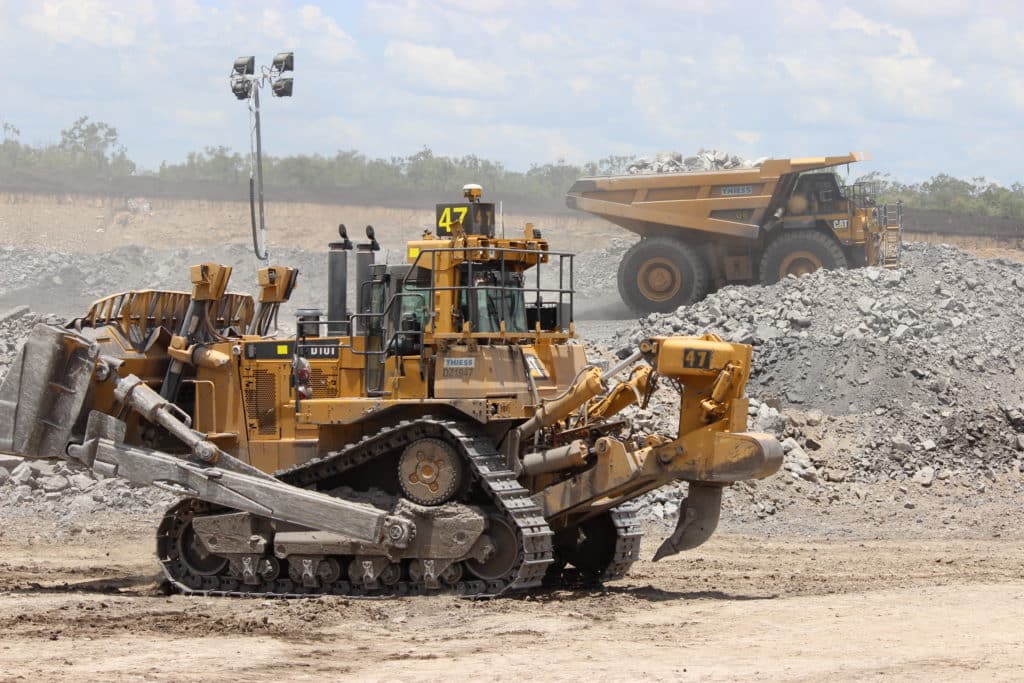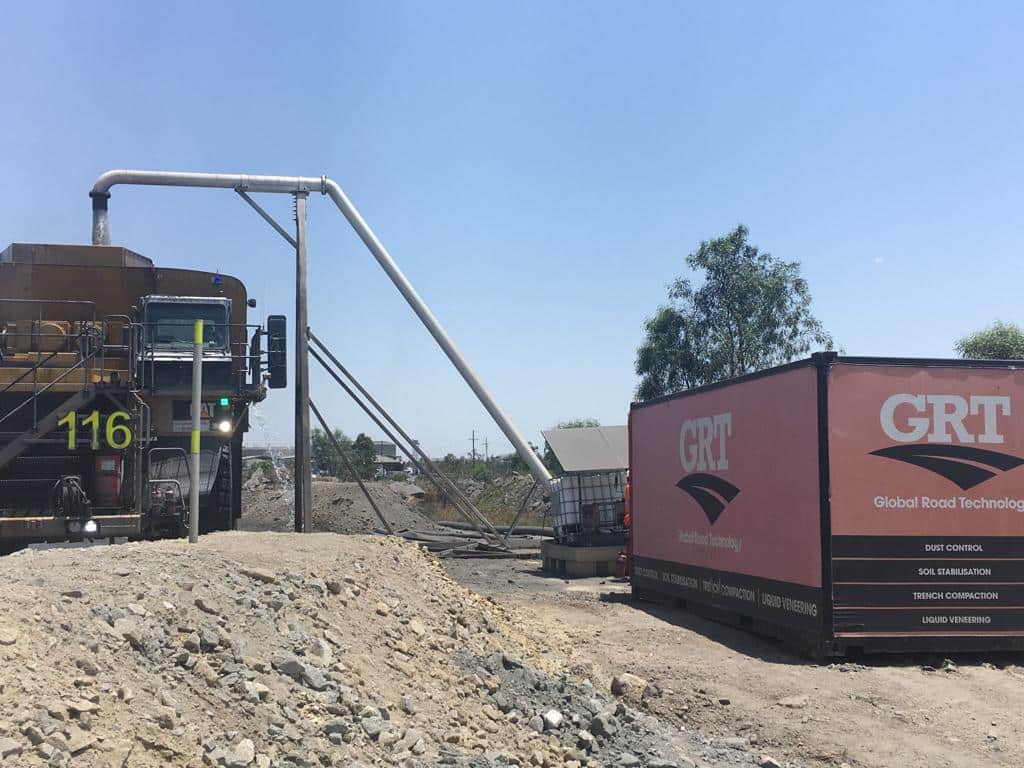Dust in open cut mining operations is an unavoidable consequence of many of the tasks intrinsically part of the industry. Accepting and understanding this is critical for all those in, or affected by the industry. By this I mean, not only staff, contractors, or suppliers onsite but also surrounding communities, family members and rural landholders.
Mining Dust Control
However, I am not advocating a fatalistic attitude towards dust in mining, as in “it is all too hard” to do anything. Acceptance and understanding is the first step to tackling and solving the problems associated with the harmful dust generated in the industry. Many sources and or impacts of dust can be managed, minimised and even eliminated through the use of products and strategies developed by companies such as GRT.
In fact – we consider any dust to be dangerous.
Is there “Safe” dust?
No.
Are environmental regulations, health and safety concerns or potential profit loss a concern right now?
In Australia, and in particular the eastern states, coal and silica dusts are understood and widely accepted as hazardous. Due to media coverage, this is also widely known in the general community. Unfortunately, many mines (and quarries) are still paying little more than lip service to their responsibilities as regulations still lean towards monitoring dust, instead of managing dust.
There is a dangerous perception that some dusts are not hazardous to our health. This is incorrect. Any dust that is small enough to enter into our lungs – no matter its chemistry – is there for keeps. Unlike our digestive system, our respiratory system has no rear exit. For workers continually exposed – even completely inert materials have a physical impact that can lead to respiratory complications such as reduced lung capacity and pneumonia-like symptoms.
Further to this, dust in mining also is linked to the following physical hazards:
- Loss of visibility on roadways – often worse at night
- Degradation of road surfaces – fines bind the surface of unsealed roads, so when these are lost to the air (dust), the surface unravels, corrugates, and potholes.
- Impact on machinery can lead to a greater risk of failure and accidents (this is also a significant financial issue as well).
Common Sources of Dust Generation in Mining
Having established that there is no “good” or safe dust, the next part of this article is looking to outline a number of common sources of dust in open cut mining operations, briefly outlining how they are caused and options used to manage them. I will then touch briefly on some strategies GRT has developed to manage these issues, however will cover this in greater detail in the next article (so stay tuned).
Drill and Blast Operations:
Whilst the blast itself is very hard to manage (as getting moisture into solid rock and ore is almost impossible), managing the drilling side of the process is actually readily achievable.
Drilling and setting charges is the pointy end of a very technical and challenging engineering discipline. It is also one of the instances in mining where people actually have to be on the ground and therefore very exposed to dust. Standard practices have been – where they can access them – to use water trucks to suppress dust on the shot areas, and utilise water in the drilling operations.

The problem with this is that soil, rock and ore, particularly in very fine particle sizes, can be hydrophobic. So no matter how much water you use, the results are patchy at best. GRT’s products GRT: Soil-Loc and GRT: Activate has been developed to overcome these issues and provide weeks (if necessary) of dust control without continual watering.
Blasting is definitely a bigger challenge, as there is no pathway to manage materials in their solid phase prior to blasting. However, suppressing the dust on the surface and also on the receiving floor can reduce the volume of available material to become airborne dust. Technologies such are GRT: Soil-Loc and GRT5000 can assist in this application.
Excavation and Loading:
Direct excavation and loading of materials is another dynamic task where managing the dust that is generated is challenging. Wetting down piles, using water trucks or even fogging cannons to provide a barrier are sometimes used. These strategies can be helpful, however if the materials are hydrophobic this can be a waste of time, or even exacerbate the problem further. Understanding the materials and their interaction with water is important.
(A quick aside: Water is a great, non-toxic and often free chemical. However it is still a chemical – so it is important to know how it interacts with the overburden and ore materials you are trying to get at).
GRT: Activate is an Australian developed and made technology that overcomes both the surface tension and charge of water, greatly improving its performance as a wetting agent.
Haul Road Dust Suppression:
These are often the first, dust-generating culprit identified onsite (although not necessarily the worst). The heavy traffic associated with haul roads, as well as their relatively short life often leads to poor construction and maintenance practices being used. Watering and continual grading is the standard practice still used in many operations. Both these practices are actually the death sentence to most roads in mining. Watering actually produces more fines due to hydraulic pumping, whilst grading keeps lowering the road profile, making roads susceptible to wet weather events. A lack of compaction processes in mining also flies in the face of good road construction and maintenance practice.
Finding a cost-effective way to utilise existing watering processes, while minimising water and water truck usage is the goal of our GRT: Haul-Loc System.
The ROM
Guilty as charged; the ROM is a big contributor to airborne dust. This impact is accentuated as it is often close to the areas that most mine staff members work in and around. This dust is obviously a respiratory hazard but along with the OHP and stockpiles can cause significant visual hazards for drivers and operators. This can be worse at night as the still, cool air means dust can hang in the air and the light from headlights and the plant itself produces the same problems as you would experience driving in fog at night.
The ROM experiences heavy traffic as haul trucks tip into the hopper and heavy plant such as loaders and dozers are continually pulverising and churning up materials on the ground. Ore tipped into the hopper creates plumes of dust, as does the material processing further down the line.
However, optimising the use of well position spraying hardware (fixed sprays and trucks) using a chemical that can overcome the potential hydrophobic and high velocity dust at these points. Water is often not the right chemical – unless treated with a product such as GRT: Activate that overcomes its high surface tension and surface charge.
OHP and Material Transfer
The OHP (Ore Handling Plant) is often recognised as the number one generator of fine dust in an open cut mine. Flying in or out of mining regions such as the Pilbara and Bowen Basin at sunset attests to this fact. Working at night also highlights this.
Once again, water is the primary chemical used to manage dust in this process. Once again, it can be limited in its effectiveness. This leads to either one of two issues:
1.Too much water is used which can lead to clogging and slipping in the crushing and transferring of ore.
2.Water is turned off because of issue 1.
As with the ROM, the right spraying hardware and chemistry is the methodology required to solve this issue. Both hardware and chemistry are critical to addressing. GRT: Activate can solve the chemistry side of this equation.
Stockpiling:
Stockpiles of ore and overburden can be a consistent source of dust whenever windy conditions prevail. This process is called wind erosion and in the case of ore actually means you are losing your moneymaking material! Stockpiles (and I consider rail wagons and trucks as mobile stockpiles) of ore may only be in place only in the short term – however, waste and overburden are often un-treated until eventually revegetated. Again, wetting down or just ignoring these problems is the most common strategy (although the liquid veneering of rail cars is common coal mining practice in Queensland).
There are easily scalable technologies readily available to the industry such as GRT: Ore-Loc, GRT: Soil-Loc, and for longer-term management, GRT: Enviro-Binder. These polymer-based technologies create a crust or film of the exposed surface that can eliminate both wind and water erosion.
Workshop Areas:
Not one often noted, the workshop area is not a huge generator of dust in the scheme of a mine’s operations, however, as with the drill and blast team, fitters and mechanics in these areas are some of the most exposed workers on any mine or quarry site. GRT has long-term dust control products such as GRT: Wet-Loc that can handle the heaviest traffic, and is actually waterless.
Concluding Remarks: Do Something!
Dust is a manageable issue in open-cut mining. However, it takes the will from both regulators and the industry to make it happen. The engagement of dust control (not just monitoring and logging) specialists is also a critical factor in a strategy’s success. I hope that this article can generate plenty of discussions – and as always we welcome your comments and feedback.
The next article in this series will focus on practical strategies to manage dust in open-cut mining in more detail.
For more details please visit: globalroadtechnology.com
Troy Adams
Troy Adams is the Managing Director of Global Road Technology (GRT) Specialising in Engineered Solutions for Dust Suppression, Erosion Control, Soil Stabilisation and Water Management. A pioneering, socially conscious Australian entrepreneur, Troy Adams is passionate about health and safety and providing innovative solutions that are cost-effective to the mining industry, governments and infrastructure sectors. Troy is also a tech investor, director of companies like Crossware, Boost, Hakkasan, Novikov and more.


